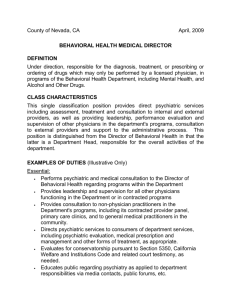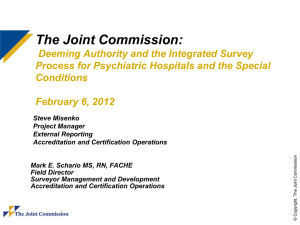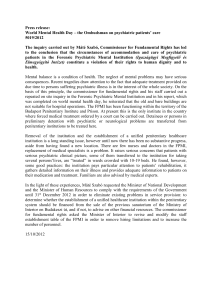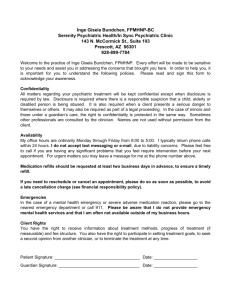In the sixteenth century, Italy had already psychiatric hospitals for
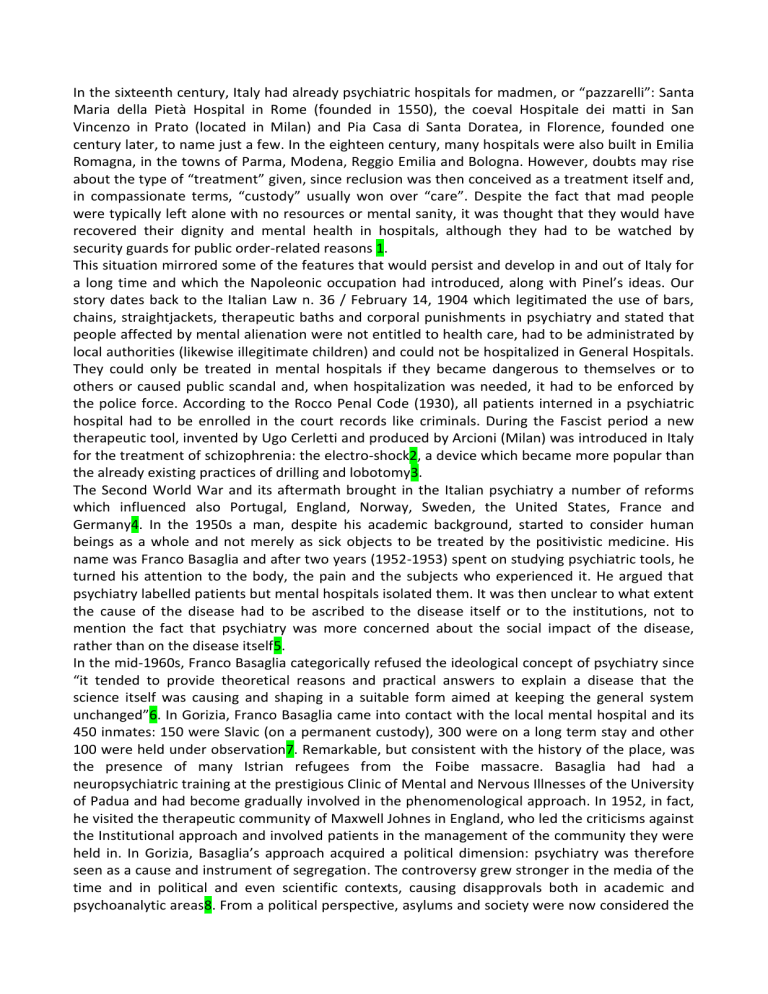
In the sixteenth century, Italy had already psychiatric hospitals for madmen, or “pazzarelli”: Santa
Maria della Pietà Hospital in Rome (founded in 1550), the coeval Hospitale dei matti in San
Vincenzo in Prato (located in Milan) and Pia Casa di Santa Doratea, in Florence, founded one century later, to name just a few. In the eighteen century, many hospitals were also built in Emilia
Romagna, in the towns of Parma, Modena, Reggio Emilia and Bologna. However, doubts may rise about the type of “treatment” given, since reclusion was then conceived as a treatment itself and, in compassionate terms, “custody” usually won over “care”. Despite the fact that mad people were typically left alone with no resources or mental sanity, it was thought that they would have recovered their dignity and mental health in hospitals, although they had to be watched by security guards for public order-related reasons 1.
This situation mirrored some of the features that would persist and develop in and out of Italy for a long time and which the Napoleonic occupation had introduced, along with Pinel’s ideas. Our story dates back to the Italian Law n. 36 / February 14, 1904 which legitimated the use of bars, chains, straightjackets, therapeutic baths and corporal punishments in psychiatry and stated that people affected by mental alienation were not entitled to health care, had to be administrated by local authorities (likewise illegitimate children) and could not be hospitalized in General Hospitals.
They could only be treated in mental hospitals if they became dangerous to themselves or to others or caused public scandal and, when hospitalization was needed, it had to be enforced by the police force. According to the Rocco Penal Code (1930), all patients interned in a psychiatric hospital had to be enrolled in the court records like criminals. During the Fascist period a new therapeutic tool, invented by Ugo Cerletti and produced by Arcioni (Milan) was introduced in Italy for the treatment of schizophrenia: the electro-shock2, a device which became more popular than the already existing practices of drilling and lobotomy3.
The Second World War and its aftermath brought in the Italian psychiatry a number of reforms which influenced also Portugal, England, Norway, Sweden, the United States, France and
Germany4. In the 1950s a man, despite his academic background, started to consider human beings as a whole and not merely as sick objects to be treated by the positivistic medicine. His name was Franco Basaglia and after two years (1952-1953) spent on studying psychiatric tools, he turned his attention to the body, the pain and the subjects who experienced it. He argued that psychiatry labelled patients but mental hospitals isolated them. It was then unclear to what extent the cause of the disease had to be ascribed to the disease itself or to the institutions, not to mention the fact that psychiatry was more concerned about the social impact of the disease, rather than on the disease itself5.
In the mid-1960s, Franco Basaglia categorically refused the ideological concept of psychiatry since
“it tended to provide theoretical reasons and practical answers to explain a disease that the science itself was causing and shaping in a suitable form aimed at keeping the general system unchanged”6. In Gorizia, Franco Basaglia came into contact with the local mental hospital and its
450 inmates: 150 were Slavic (on a permanent custody), 300 were on a long term stay and other
100 were held under observation7. Remarkable, but consistent with the history of the place, was the presence of many Istrian refugees from the Foibe massacre. Basaglia had had a neuropsychiatric training at the prestigious Clinic of Mental and Nervous Illnesses of the University of Padua and had become gradually involved in the phenomenological approach. In 1952, in fact, he visited the therapeutic community of Maxwell Johnes in England, who led the criticisms against the Institutional approach and involved patients in the management of the community they were held in. In Gorizia, Basaglia’s approach acquired a political dimension: psychiatry was therefore seen as a cause and instrument of segregation. The controversy grew stronger in the media of the time and in political and even scientific contexts, causing disapprovals both in academic and psychoanalytic areas8. From a political perspective, asylums and society were now considered the
pathologic causes of disease: not only psychiatric hospitals caused degeneration in the disease, but they also had a clear pathogenic connection with the society. 1965, underpinning his interest in the Anglo-Saxon philosophy, Basaglia introduced in London the concept of “Institutionalization” comparing it to an “emotional void”9, designed for the destruction of individuality and the objectification of the patient. If mental illness causes alienation, asylum amplifies this effect and causes the isolation of patients from their past and individuality: this is exactly what individuals usually experience within society, with only more freedom left for personal initiatives. Sick people must be therefore encouraged in the search for themselves and their freedom and must break the paternalistic bond with doctors. Basaglia conceives a more aggressive and emotional approach that will lead to a new form of therapeutic community, shifting from the old model of psychiatric hospital to a new one, referred to as “the community of feelings”10, inextricably based on the aggressiveness of patients and operators. Indeed, institutionalization causes isolation of patients, doctors and assistants but for patients, mainly, aggressiveness represents the first step to the dissolution of the paternalistic and chronic dependence from doctors.
Italy, also, was getting gradually ready for a change and the 1968 Law n. 431 (known as Mariotti
Act, after the name of the Ministry of Health of the time), took psychiatrists out of the “ghetto” of non-medical sciences and psychiatric hospitals underwent an administrative reform which brought them closer to the organization of General Hospitals. The enrolment of patients in the court records was abolished and, in that moment, new basis were laid for the promotion of psychiatric treatment outside the hospital network and the creation of Centres of Mental Health. Also, the
Mariotti Act introduced voluntary internment into psychiatric hospitals and changed the previously compulsory internments into voluntary ones. This act offered a new possible vision and brought political and intellectual forces together in order to accomplish a reform that aimed at abolishing institutions, something that Basaglia was simultaneously doing in Gorizia and that, in 10 years’ time, would bring to enact Law n. 180.
Basaglia pointed out that Italy was following a different approach from England where, according to 1959 Mental Health Act, hospitalization was determined on the basis of patient’s dangerousness and voluntary internment was unacceptable. Compulsory internment became the
“estrema ratio” and also an evidence of the society’s ineptitude to face this discomfort11.
Therefore, while the Government was working on reforms and Basaglia was developing a new theory, the culture of Anti-Psychiatry based on social-political considerations about the new treatment of mental illness was gradually spreading. The bio-medical concept was challenged by a globally human approach, which not only questioned the theory and practice of psychiatry, but also started the process of deinstitutionalization and fought against the prevailing culture of medical practice and the society’s underlying structures. In this turmoil, new wards were opened in the Clinics for Nervous and Mental Illnesses: they became known as Observation Wards, completely different from Psychiatric Hospitals and also forerunners of today’s Psychiatric
Diagnosis and Treatment Service.
Unlike ten years earlier, Basaglia was now stepping back from the English approach, since he could see that the promising community based therapy would become institutionalized, after enforcing the strict rules of psychiatric hospitals12.
On May 13, 1978 the Italian Parliament enacted Law n. 180 about the compulsory health treatment approved by the Mental Health Commission of the Italian Senate, headed by Adriano
Ossicini. The Law, commonly and improperly known as the Basaglia Act, introduced the abolition of psychiatric hospitals, which is still today the basis of the national psychiatric support service.
Psychiatric hospitals were replaced by Psychiatric Diagnosis and Treatment Service inside General
Hospitals where it is still possible to have access to voluntary hospitalization and compulsory health treatments (TSO in Italian), applied only when a patient refuses obviously needed
treatments and no other effective care is available outside the hospital network. Law n. 180 overtakes the idea of custody and the same TSO must be approved by the Mayor, upon request of the family doctor and the validation of a psychiatrist from the National Health System. Also, TSO must be validated by a supervising judge and enforced by urban police for a maximum time of seven days, although it can be repeated or changed into a voluntary hospitalization.
Basaglia’s commitment in the transformation process of psychiatric hospitals was mainly based on the idea of trusting patients, which he considered to be a winning approach against asylums.
However, from a political point of view, he saw that the connection between the psychiatric issue and the class struggle brought the first to the attention of the political world. Basaglia understood that it was possible to develop a new concept of mental hospitals and prevention against mental illnesses throughout an increased awareness of the social-economic context, particularly in terms of poverty and margination.
He was not a man from the Academy, he was not a lecturer but he took the risk to act as an empirical and pragmatic person who refused the enlightening, idealistic and flattening side of an exasperated theory, which had been conceived to hide contradictions13.
Among the evident innovations brought about by Basaglia who made the patient-doctor relation more human, some are worth mentioning, for example the knocking down of the walls surrounding mental hospitals, the abolition of insulin therapy and electroconvulsive therapy and the reduction of physical means of constraint, still representing the most controversial aspects of the reform. Certainly, the straightjacket and the physical constraint to bed are still considered violent and aggressive means. However, the psychiatric drugs which have spread since 1950 (when
Chlorprozamine was discovered) brought to a similarly unethical use of “pharmacological straightjackets”. Another serious problem which had not been taken into account by the reform, was that the introduction of psychiatry in General Hospitals would imply the accomplishment of budget and timeline goals with a consequent reduced interest in patients’ health .
As for the economic implications, Law 180 turned out to be inadequate. At the time of its enactment, the social-economic conditions of the country were definitely more favorable in many ways and, as a consequence, Finance reforms were not thought to be needed. However, due to the recent economic crisis, all industrialized Western countries have had to rearrange the distribution of available resources and the welfare system, which used to guarantee the community-based psychiatric care, has suffered severe reductions, too. Since unemployment, isolation and poverty are severely affecting the communities, the Government will not presumably address further resources to capillary, peculiar and invisible welfare and rehabilitation networks, but, instead, will prefer to address resources and other social helps to business sector and other more institutionalized causes, as proved by the uncountable cuts implemented in the Health system and the postponed shutting down of six operating Forensic Psychiatric Hospitals.
As a reaction, many spontaneous volunteer associations of family members and users have been created and they may be considered the real and unique help in a society where mutual help is slowly vanishing and the stigma of mental illness hasn’t disappeared yet. The concept of mental disease has mixed up and identified with groups of drug addicts or immigrants whose culture, values, taboos, behaviors and reactions are different from the local ones. The concept of mental disease has been extended to the increasing number of unemployed, isolated, abandoned and old people, all blended in a sort of anthropological-ethnical mixture, and left without any of the economic and financial helps, which are vital to meet these new growing needs.
Further thinking is usually stimulated by the story of Geel, the Dutch village where the adult foster family care (IESA) approach to psychiatric patients was introduced in medieval times, far before the Basaglia reforms. Today, this practice of sharing and acceptance has also been applied in some
Italian cities through projects on psychiatric adult foster family care. Basaglia, too argued that the
families of origin needed to accept the disease of their member who, after the internment in some psychiatric hospital, often became like a ghost.
Today, psychiatry is taking distance from all forms of reductionism and simplification and it represents an ever-evolving medical science which embraces new disciplines, both highly specialized, such as neuroscience, and not strictly medical ones such as psychology, sociology, pedagogy, anthropology and ethics. Likewise, one of the most valuable aspects which came out in the period after Basaglia is the opening of a new dialogue with mental health specialists along with sociologists, trade unionists, philosophers and politicians.
Notes
1 Lisa Roscioni. Il governo della follia. Ospedali, medici e pazzi nell’età moderna, Bruno
Mondadori 2003.
2 Paolo Francesco Peloso, La guerra dentro. La psichiatria italiana tra fascismo e resistenza
(1922-1945), Ombre Corte, Verona.
3 Valeria Babini, Liberi tutti. Manicomi e psichiatri in Italia: una storia del Novecento, il Mulino,
Bologna 2009, 93-115.
4 Dalle trincee al manicomio. Esperienza bellica e destino di matti e psichiatri nella Grande
Guerra, a cura di A. Scartabellati, Marco Valerio, Torino 2008.
5 F. Basaglia - F. Basaglia, Introduzione, in E. Goffman, Asylums. Le istituzioni totali: i
meccanismi dell’esclusione e della violenza, Einaudi, Torino 1968, 10.
6 Franca Ongaro Basaglia, Introduzione generale ed esposizione riassuntiva dei vari gruppi di
lavori, in Franco Basaglia, Scritti 1. 1953-1968, Einaudi, Torino 1981, XXII.
7 Franco Basaglia, La «comunità terapeutica», in Id., Scritti 1. 1953-1968, Einaudi, Torino 1981,
263.
8 Franca Ongaro Basaglia, Introduzione generale ed esposizione riassuntiva dei vari gruppi di
lavori, in Franco Basaglia, Scritti 1. 1953-1968, Einaudi, Torino 1981, XXIV-XXV.
9 F. Basaglia, La distruzione dell‘ospedale psichiatrico, in Id., Scritti 1. 1953-1968, Einaudi,
Torino 1981, 250.
10 Franco Basaglia, La «comunità terapeutica», in Id., Scritti 1. 1953-1968, Einaudi, Torino
1981, 272.
11 Franco Basaglia, Legge e psichiatria, in Id., Scritti 2. 1968-1980, Einaudi, Torino 1982, 461-
462.
12 F. Basaglia, Conversazione sulla Legge 180, in Id., Scritti 2.1968-1980, Einaudi, Torino 1982,
476.
13 Franco Basaglia, Conversazione sulla Legge 180, in Id., Scritti 2.1968-1980, Einaudi, Torino
1982, 484.

